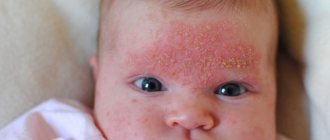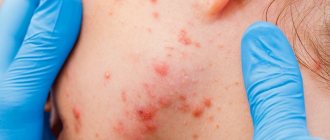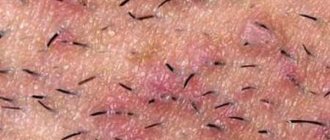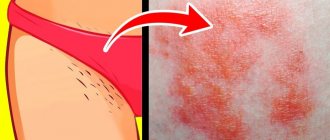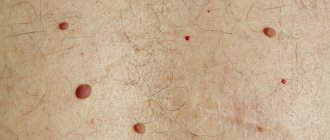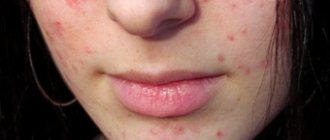- Pimples in the groin in women Causes?
- Other causes of acne in the groin in women
- Purulent and bloody pimple in the groin of women
- Is it safe to squeeze a pimple in the groin?
- Internal and subcutaneous pimple in the groin in women
- How are acne in the groin usually treated?
- Tips for preventing acne in the groin area
Key points of the article:
- Vaginal acne is usually not a serious condition.
- Shaving your pubic hair can cause acne if the hair follicles become infected.
- In most cases, acne goes away on its own or with treatment within a few weeks.
Few parts of the body are as sensitive as the female genital and groin areas. Vaginal acne is not usually a serious condition, but it can be a source of great discomfort.
Later in the article, you will find the main causes that can cause pimples in or around the vagina, as well as tips on how to treat and prevent them.
Pimples in the groin in women Causes?
The reason is not always obvious, but there are several reasons why you may have acne around your genitals. Some of them are:
Contact dermatitis
Vaginal acne in women is likely caused by contact dermatitis. Contact dermatitis in the groin can be caused by sensitivity to:
- bubble bath procedures using aggressive soaps, especially if they contain strong fragrances,
- feminine wipes, deodorants, lotions, powders or perfumes,
- tampons or sanitary pads,
- spermicides, condoms, lubricants or sexual stimulants,
- antibiotic drugs,
- washing powders that you use to wash your underwear.
Your skin may also become irritated due to:
- Sweating due to wearing synthetic underwear and tight jeans,
- vaginal discharge,
- urine ingress,
- sperm.
Any skin irritation can lead to acne formation.
Acne as a symptom of relatively harmless dermatological diseases
Not all intimate rashes are dangerous.
Contact dermatitis: allergic manifestation to detergents or synthetics
Thus, the appearance of acne can be caused by neglect of hygiene requirements during shaving or a banal allergic reaction to synthetic underwear material:
- Inflammation of the sweat glands. It occurs as a result of infection of the gland by staphylococcus due to poor hygiene or damage to the skin. Pimples are painful and itchy.
- Contact dermatitis. The manifestation of an allergic reaction in response to synthetic material of underwear or personal hygiene products. Characterized by the presence of small itchy pimples, redness, and swelling.
- Furunculosis. An inflammatory process in the follicle, which is characterized by the gradual formation of a large pimple. Over time, a purulent core forms, which either opens on its own or requires surgical opening.
- Acne. It may be the result of hormonal changes, the use of low-quality personal hygiene products, or failure to comply with hygiene standards.
Despite the fact that such rashes are relatively safe, they still require contact with a specialist.
Hidradenitis inguinalis is an inflammation of the inguinal sebaceous glands caused by the penetration of Staphylococcus aureus
Other causes of acne in the groin in women
Poll: When did your acne appear? (Number of votes: 4295)
I've been suffering all my life
It's been a couple of years now
About a few months
Recently
To vote, click on the desired answer. results
Some lesions may appear to be pimples, but are actually cysts, warts, or other skin conditions in the groin area. The most common ones are:
Bartholin's cysts - usually found near one side of the vaginal opening. If the cysts do not go away within a few days or become painful, see your doctor. Large cysts can be a major symptom of a type of vulvar cancer called Bartholin's gland cancer.
Genital herpes are lesions that can look like pimples in the groin area of women. They appear around the vagina, vulva and anus. Genital herpes can only be treated under the strict supervision of a physician, because it is a fairly serious infectious disease.
Genital warts can also be mistaken for groin pimples. You can have a single wart or even a cluster of small warts. They are caused by the human papillomavirus (HPV), a common sexually transmitted infection (STI).
Folliculitis: Pimples in the genital area can be the result of an infection of the hair follicle caused by various infections. Shaving pubic hair is one of the potential causes of folliculitis and red pimples in the groin To avoid irritation, shave only in the direction of hair growth. In some cases, hair grows in the opposite side, and shaving them can cause not only inflammation, but also ingrown hairs.
Sliding a razor over sensitive skin can also cause the following symptoms of irritation:
- "razor burn"
- pimple-like bumps
- rash of small pimples
- pimples.
Inversion acne is a chronic disease of the sweat glands. The disease causes pimple-like lesions on the body, including the groin area. The cause of this rare inflammatory disease is unclear. There are symptoms but no cure yet.
Molluscum contagiosum is a viral infection that can cause pimples anywhere on the body, including the groin in women. Treatment is not always necessary, but it can be treated with topical or oral medications. If necessary, your doctor can remove the pimple yourself.
Getting rid of acne at home
If a woman rules out sexually transmitted diseases, you can get rid of some types of acne (except subcutaneous acne and Bartholin gland cysts) at home.
Before carrying out the procedures, you must thoroughly wash the groin area with acne with soap and water and rinse with warm boiled water. Dry with a clean towel, do not rub or stretch the damaged skin. Then you can use the following methods:
- For purulent acne, apply a thin layer of Vishnevsky, Ichthyol or Levomekol ointment to clean skin 2 times a day. If the lesions do not go away within 5-6 days of self-treatment, consultation with a dermatologist (gynecologist) is necessary.
- To dry the pustules and accelerate their maturation, apply a cotton swab soaked in iodine locally for 5-10 minutes. Carry out the procedure twice a day. As a rule, on the 3-4th day the purulent contents come out.
- Aloe applications. Pour boiling water over a freshly cut aloe leaf, cut off the top layer (film), edges and apply to the problem area for 3-4 hours, attaching it with a paper-based plaster. After 3-4 days of such applications, the pimple goes away.
You can use home remedies to treat acne in the groin area in women only after consulting a doctor. And also as an additional measure during drug therapy.
Purulent and bloody pimple in the groin of women
A boil, or skin abscess, is the main cause of purulent and, in more severe stages, bloody pimples in the groin in women and men. A boil is an accumulation of pus that forms in the skin and includes symptoms and signs such as:
- hard, reddened swelling
- sensitive, swollen skin around a large pimple,
- the swelling can vary in size - from a small pea to a large walnut, but even the smallest boil is larger than a regular pimple in size and shape.
- rapid filling of the boil with pus, which can spontaneously increase to sizes that are non-standard for a pimple.
Only antibiotics prescribed by your doctor are an adequate treatment for abscesses and boils. Primary treatments for inflammation include warm compresses and drainage (opening by piercing) of the abscess, but only when it is soft and ready to drain pus.
The procedure must be carried out by a doctor under sterile conditions with special instruments. Most purulent boils resolve on their own or with the help of home remedies and compresses. Bloody pimples and boils require urgent medical attention.
Furuncle on different parts of the skin, how to treat?
Squeezing a cystic pimple
Is it safe to squeeze a pimple in the groin?
It is better not to even try to squeeze out a vaginal pimple on your own. On the one hand, squeezing the pimple can lead to the spread of bacteria and the development of infection. On the other hand, irritation very easily occurs in this sensitive area, which will only worsen your condition.
The pimple may become inflamed, even filled with pus, and continue to grow at a blisteringly fast pace over the next few days. As it grows, it may also become painful.
Do not poke or squeeze pimples near the genitals (there is a chance that the pimple may burst on its own). Instead, see a doctor who will perform the removal procedure in a way that prevents infection.
Internal and subcutaneous pimple in the groin in women
Internal and subcutaneous pimples are 99% of the time the cause and symptom of cystic acne - the most serious and painful type of acne. It develops quite rapidly when cysts form deep under the skin. It can be the result of the activation of certain bacteria, oil and dead skin cells that become trapped in your skin. pores.
Cystic acne tends to occur in people with oily skin. This condition is also more common in teenagers, women, and older adults with hormonal imbalances.
Typically, cystic internal and subcutaneous acne goes away with age. However, persistent and painful acne will not go away on its own. If you suspect that you have cystic acne, an urgent visit to a dermatologist will be your best decision towards cystic acne treatment.
Cystic acne Treatment and causes.
How are acne in the groin usually treated?
Pimples caused by minor irritation may go away on their own without much consequence. If they do not go away, or if the skin in the groin area worsens significantly, consult a doctor.
Acne in the groin in women caused by contact dermatitis can be treated with medications that are prescribed individually to each patient. If an allergic reaction is diagnosed, antihistamines can be prescribed.
If you are diagnosed with contact dermatitis, your doctor will first need to determine the cause of its formation through an external examination and based on the results of a skin analysis. You will also need to stop using any cosmetic products in the genital area.
Pimples caused by ingrown hairs also usually go away on their own. Early diagnosis and self-treatment of pimples caused by ingrown hairs can only make the situation worse. Also, treatment is not always necessary for molluscum contagiosum. If it doesn't go away on its own within a week, your doctor may prescribe a topical or oral medication for its prompt removal.
If you don't know what's causing your acne, avoid using any medications and seek advice from your doctor to avoid making the situation worse.
Forecast.
In most cases, acne goes away on its own or with the help of additional treatment within a few weeks. The predicted result of treatment depends on the causes of acne in the groin and the chosen treatment methods. Your doctor can give you a more precise answer to the question of what you can expect.
You may need to make some adjustments to your personal hygiene routine to prevent the skin condition in your groin area from recurring.
Features of treatment
If subcutaneous, purulent pimples or wen are detected, urgent consultation with specialists is necessary. The disappearance of symptoms and a decrease in the size of the rash does not indicate independent treatment; the disease becomes chronic, gradually destroying the immune and reproductive systems.
Treatment of subcutaneous pimples (pimples) in the groin in women is carried out surgically - by opening the formation, washing the wound from the contents and treating it with disinfectants.
To treat a Bartholin gland cyst, the method of surgical excision (marsupialization) of the abscess is used with further installation of a word-catheter at the mouth of the gland. Followed by antibiotics.
Treatment of acne of allergic origin is carried out in several stages:
- Elimination of provoking factors (synthetic underwear, thongs, pads with fragrances, etc.),
- Careful personal hygiene using specially designed pharmaceutical products,
- Taking antihistamines and sedatives.
To treat genital psoriasis in women, symptomatic therapy is prescribed, which allows you to get rid of discomfort, itching, and other unpleasant symptoms. Symptomatic therapy involves taking:
- Local ointments (creams) with non-hormonal effects (Salicylic, Zinc ointments),
- Corticosteroid drugs (Hydrocortisone, Cortisone),
- Multivitamins, fish oil.
With normal immunity, molluscum contagiosum goes away on its own. However, in some cases surgery is required. The most commonly used methods are electrocoagulation, cryodestruction, and surgical excision.
Treatment of purulent acne in the groin in women includes:
- Antibacterial agents,
- Treatment and opening of pustules with subsequent treatment of the wound with disinfectant solutions,
- Application of wound-healing ointments, creams (Levomekol, metronidazole-based ointments, streptocidal ointment, etc.).
Purulent acne in the groin in women should be treated only in a medical setting. It is strictly forbidden to self-medicate for this type of rash, regardless of the reasons for its appearance.
Treatment of sexually transmitted diseases is carried out:
- Antibiotics in the form of tablets, injections. If there is an allergic reaction to penicillin, then antibiotics from the macrolide group, cephalosporins,
- Antiviral drugs (Valvir, Acyclovir, Vivorax),
- Immunomodulators (Immunal, Afalaza, Immudon).
The duration of treatment and an additional set of therapeutic measures are determined by the doctor, taking into account the duration of the disease, the degree of development of the disease, its form and severity.
The duration and effectiveness in the treatment of purulent, subcutaneous (internal) acne in the groin in women depends on the woman’s timely visit to a medical facility and the necessary tests (for HIV infection, TORCH, vaginal candidiasis).
Tips for preventing acne in the groin area
As soon as your doctor diagnoses the exact cause of your acne, immediately begin comprehensive therapy, avoiding contact with the irritant. To prevent further irritation in the groin, follow these generally accepted recommendations:
- Avoid tight clothing that may cause friction
- Choose cotton underwear rather than synthetic material
- Try not to touch the pimples too much.
- Avoid very hot water when taking baths.
- Use only gentle baby soap or intimate gel.
Since shaving can irritate the skin and cause pimples around the private parts in both women and men, you can stop using a regular razor for a while, but you can trim your pubic hair with scissors. If you do decide to shave your groin hair, only go with the razor at a growth angle your hair with a downward slope.
If you have any unusual swelling or a sharp increase in the number of acne in the genital area, consult your doctor for a diagnosis and further treatment.
We also recommend that you read the first part of the article: Pimples near and in the vagina Causes Treatment. .
Causes of rashes
Acne can be caused by a variety of reasons. A rash in the groin area may indicate the presence of pathologies, malfunctions of any organ, or be completely harmless.
The appearance of acne in an intimate place should alert a man, and the pathology should be treated after consultation with a dermatologist
To understand whether acne is dangerous or not, it is important to identify the causes of its occurrence:
- weakened immune system;
- presence of sexually transmitted diseases;
- improper shaving;
- eating low quality foods;
- insufficient hygiene of the body and groin area in particular;
- a history of diabetes mellitus;
- hormonal imbalances that occur during adolescence or as a result of taking hormonal medications;
- frequent stress, psycho-emotional stress;
- allergic reaction of the body to food, hygiene products, medicines, underwear;
- dermatological diseases.
To prevent the development of complications or serious consequences of the rash, it is important to immediately consult a specialist to clarify the diagnosis and receive the necessary recommendations for treating the disease.
Acne in the male intimate area can be divided into non-dangerous acne and formations, which can be symptoms of diseases




